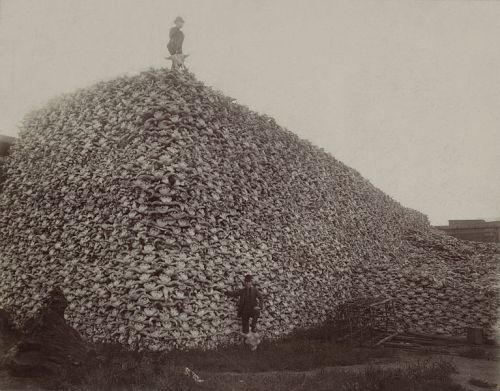
- American Bison
‘Meat is murder’ sang Morrissey. But, lets accept the facts, no matter how lovely that crotchety vegetarian might croon, American’s are a carnivorous bunch, consuming an average of 183 pounds per person annually. And while that might be an excessive quantity, being an omnivore doesn’t have to leave one with an unresolvable sense of guilt. Eating meat can actually be good for the species, the environment, and our bodies. That is, if we adopt some changes to our diet, one delicious change–eat more bison.
The American Bison, or American Buffalo, once blanketed the US landscape. Ranging from Washington to New York, Florida to Montana, bison were considered to be the most numerous single species of large wild mammal on the Earth. But the 19th century was a horrific one for bison as Americans began slaughtering them in staggering numbers. As frivolously shot carcasses lay rotting, as boastful men erected mountains of skulls, the American bison’s population, historically exceeding 60,000,000 dwindled to less than 300 by 1893. An emblem of American bravado and strength was nearly rendered extinct.
As the population of bison diminished, so too did their native grassland habitat. No longer roamed by the largest heard in the world, millions of acres of healthy grasslands, which once covered more than 45% of the US, were divided, fenced, and reclaimed for human habitation, cattle ranching and large scale farming. Ironically, the diverse and balanced grassland ecosystems–which hold the world’s highest potential for carbon sequestration–were replaced by staples of the vegetarian diet, notably soy and corn, which require huge quantities of water, chemical fertilizers and toxic pesticides.
But thanks to the efforts of a few who saw both a responsibility to preserve the breed as well as its value as a food source, bison have made a steady return. Lower in fat and cholesterol, yet higher in protein, bison is a fantastic replacement to cattle and require far less human intervention. Raised on open ranges for most of their lives (some are grain fed in the last 90-120 days), bison are a vital component in the grasslands ecosystem, and do humans a serviceable job of digesting those grasses that our stomachs cannot.
Just over a hundred years after bison were nearly eradicated at the hands of man, it is their brains and stomachs that have given the American bison a second chance, with annual consumption over 20,000 and the species climbing up the Conservation Status’s registry, one step away from reaching the highest label of ‘Least Concern’.
Now if that’s not a reason to celebrate with a bison steak, I don’t know what is.
Bison is sold at numerous food retailers around Austin, including…
http://www.thunderheartbison.com/
Written by Avery Thompson


